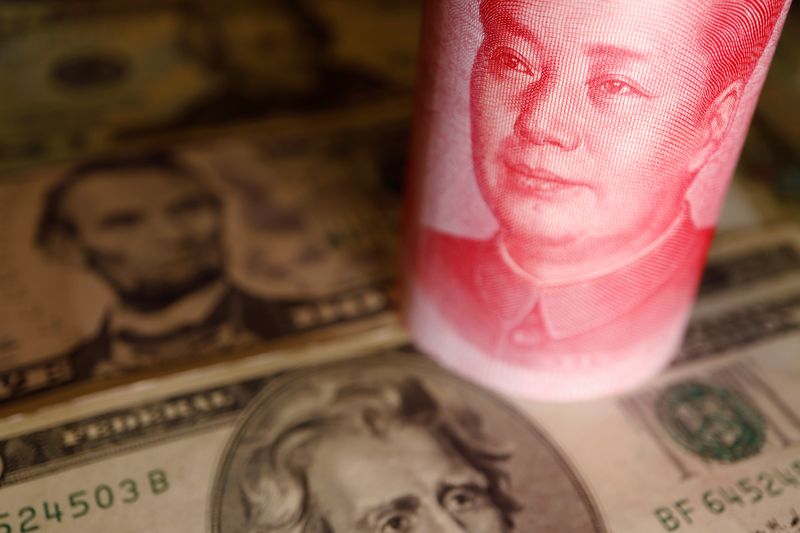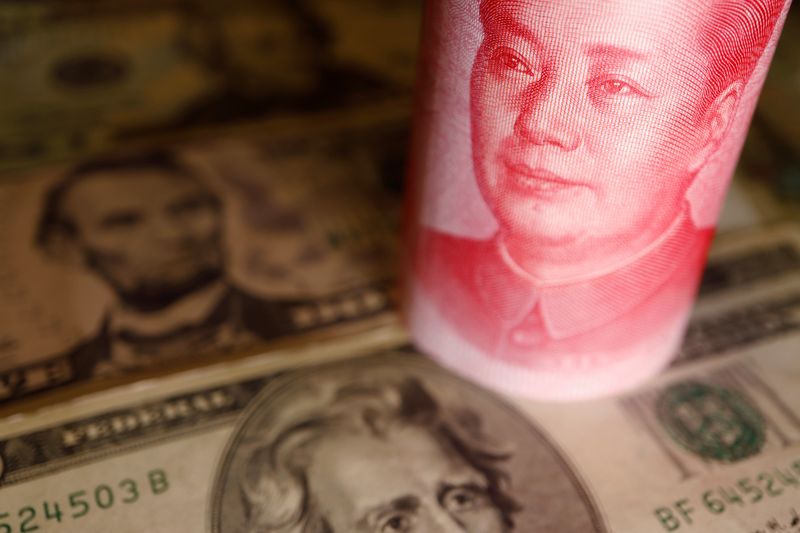Forex
Dollar rises to six-month high after US data; weak yen prompts warning


© Reuters. FILE PHOTO: U.S. Dollar and Chinese Yuan banknotes are seen in this illustration picture taken June 14, 2022. REUTERS/Florence Lo/Illustration/File Photo
By Gertrude Chavez-Dreyfuss
NEW YORK (Reuters) – The dollar climbed to a six-month peak on Wednesday, reversing earlier losses, after U.S. data showed the services sector surprisingly picked up steam last month amid a rise in new orders and businesses paying higher prices, suggesting persistent inflation pressure.
The greenback recovered against most currencies after the data, with the euro and sterling hitting three-month lows and the yen touching session troughs. The U.S. currency, however, pulled back a bit in the afternoon as volume thinned.
The was last at 104.84, up 0.1%, after earlier hitting a fresh six-month high of 105.03.
The euro and sterling fell to three-month lows after the data and were last flat at $1.0726 and down 0.5% at $1.2505, respectively.
Data showed the Institute for Supply Management (ISM)’s non-manufacturing PMI rose to 54.5 last month, the highest since February and up from 52.7 in July. Economists polled by Reuters had forecast the non-manufacturing PMI would decrease to 52.5.
“It’s clear the U.S. economy remains much stronger by comparison than most of the rest of the G10 and runs substantially less risk of entering a recession,” said Helen Given, FX trader at Monex USA in Washington.
“With the UK and the eurozone teetering on the brink of true contraction, investors really have little choice but to place their faith in the U.S. (economy).”
The data suggested interest rates will remain elevated for longer, although it does not alter expectations that the Federal Reserve will pause its rate hikes at a meeting later this month.
For the November and December policy meetings, the chances of a rate hike increased to 48.4% and 46.6%, respectively, on Wednesday, according to the CME’s FedWatch. Those odds were at 45.2% for November and 43.5% for December late on Tuesday.
Fed officials the last two days, however, struck a dovish tone suggesting the U.S. central bank could pause again for the next several meetings to further assess the impact of monetary tightening on economic data.
Boston Fed President Susan Collins said Wednesday the central bank will proceed carefully when it comes to its next monetary policy steps.
Her comments followed similar remarks by Fed Governor Christopher Waller on Tuesday. Waller said in a CNBC interview that “there’s nothing that is saying we need to do anything imminent anytime soon, so we can just sit there, wait for the data, see if things continue” on their current trajectory.
Against the yen, the dollar trimmed losses, last down little changed at 147.69 yen. Earlier in the session, it rose to 147.82, the lowest since Nov. 4.
The currency market remains on yen-intervention watch, however.
The yen strengthened to as much as 147.02 per U.S. dollar after Japan’s top currency diplomat, Masato Kanda, said they will not rule out options if speculative moves persist, the strongest warning since mid-August.
Kanda, Japan’s vice-minister of finance for international affairs, has been the central figure in the country’s efforts to stem the sharp decline of the yen since last year.
Japan intervened in currency markets 12 months ago when the dollar rose past 145 yen, prompting the Ministry of Finance to buy the yen and push the pair back to around 140 yen. It intervened again in October last year when the currency pair hit 150 yen.
Also on Wednesday, the Fed released its so-called “Beige Book”, a snapshot of the U.S. economy. The report showed a moderation in economic growth in recent weeks, with inflation slowing in most parts of the country.
The dollar showed little reaction to the report.
========================================================
Currency bid prices at 3:56PM (1956 GMT)
Description RIC Last U.S. Close Pct Change YTD Pct High Bid Low Bid
Previous Change
Session
Dollar index 104.8300 104.7500 +0.09% 1.295% +105.0300 +104.5900
Euro/Dollar $1.0726 $1.0722 +0.04% +0.10% +$1.0749 +$1.0703
Dollar/Yen 147.6550 147.7000 -0.03% +12.62% +147.8150 +147.0200
Euro/Yen 158.38 158.39 -0.01% +12.88% +158.4600 +157.7800
Dollar/Swiss 0.8913 0.8897 +0.17% -3.61% +0.8944 +0.8882
Sterling/Dollar $1.2505 $1.2564 -0.45% +3.42% +$1.2587 +$1.2484
Dollar/Canadian 1.3640 1.3641 -0.01% +0.67% +1.3675 +1.3623
Aussie/Dollar $0.6379 $0.6379 +0.02% -6.41% +$0.6405 +$0.6359
Euro/Swiss 0.9561 0.9536 +0.26% -3.38% +0.9575 +0.9534
Euro/Sterling 0.8575 0.8533 +0.49% -3.04% +0.8577 +0.8529
NZ $0.5870 $0.5884 -0.23% -7.55% +$0.5903 +$0.5860
Dollar/Dollar
Dollar/Norway 10.7180 10.7080 +0.14% +9.26% +10.7510 +10.6780
Euro/Norway 11.4989 11.4909 +0.07% +9.58% +11.5236 +11.4648
Dollar/Sweden 11.1172 11.0921 +0.26% +6.82% +11.1408 +11.0597
Euro/Sweden 11.9253 11.8944 +0.26% +6.96% +11.9373 +11.8878

 Forex3 years ago
Forex3 years agoForex Today: the dollar is gaining strength amid gloomy sentiment at the start of the Fed’s week

 Forex3 years ago
Forex3 years agoUnbiased review of Pocket Option broker

 Forex3 years ago
Forex3 years agoDollar to pound sterling exchange rate today: Pound plummeted to its lowest since 1985

 Forex3 years ago
Forex3 years agoHow is the Australian dollar doing today?

 Cryptocurrency3 years ago
Cryptocurrency3 years agoWhat happened in the crypto market – current events today

 World3 years ago
World3 years agoWhy are modern video games an art form?

 Commodities3 years ago
Commodities3 years agoCopper continues to fall in price on expectations of lower demand in China

 Economy3 years ago
Economy3 years agoCrude oil tankers double in price due to EU anti-Russian sanctions

























